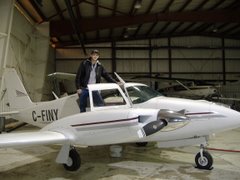Our last flight lasted 8 minutes, and now we're grounded waiting for parts. An engine driven fuel pump that is. I was PNF (Pilot Not Flying) for that flight, so my duties involved monitoring engine instruments on take-off and making the required cockpit calls (Full Power Confirmed, Gauges Green, Airspeed Alive, 95 mph, Rotate, etc) and completing the after-takeoff checklist.
We took off, everything normal, and I started to complete the after-takeoff checklist on our climb through 500 ft. As I turned off the left Emergency fuel pump I watched the fuel pressure gauge to make sure the pressure didn't drop out (which would indicate an engine-driven fuel pump failure, and an immanent engine failure). Except this time as I flicked off the overhead switch the pressure DID drop out. Huh, didn't expect that.
At about the same time I watched the drop in fuel pressure, the Captain saw the Low Fuel Pressure light illuminate on the enunciator panel. I quickly flicked the switch back on just as the left engine started to cough. We turned around and landed without incident.
This is a very good example of why emergency fuel pumps exist, and why we employ the good practice of turning them on for take-off, and then then turning them off one at a time after takeoff. And also in a broader sense of how airplanes are designed so that stuff can break, but the airplane can still fly just fine.
Just like a Twin Comanche, the Navajo is equipped with an engine driven fuel pump, which does just what its name says. Normally the engine driven fuel pump is what provides fuel to the engine in normal flight, but if it were to fail, the engine would stop producing power. So we have a set of emergency fuel pumps, which do the same thing, except they are powered electrically as a back-up system. Without the emergency pumps turned on it would be a real bummer if the engine driven pump failed during takeoff, because that would mean the engine would quit, and we'd be stuck troubleshooting a failing engine during the most critical and time-sensitive phase of the flight. So its good practice to turn the emergency pumps on for every take-off we perform. That way if the engine driven pump fails, it will only affect the performance of the engine when we go to switch the emergency pump OFF.
So that's what we do. We only switch OFF the emergency pumps after we're a certain height above the ground such that we have time to troubleshoot potential problems without immediate action being required. Furthermore its good practice, for obvious reasons in light of our last flight, to turn off each fuel pump one at a time, and watch for any changes in fuel pressure. If we were to flick off both pumps at the same time, it would be far less intuitive to correctly identify which engine was in the process of failing.
On Tuesday all the cautious procedures paid off, and our fuel pump failure was a non-incident. Had we not been exercising good practice it is very possible we would have had an engine failure during takeoff.
The system works.




Seems to me that redundancy saves lives but only if the procedures are followed. The more I read and hear about your exploits it becomes clearer that all the 'systems' in the world can't correct for a bad pilot.
ReplyDeleteThat's very true
ReplyDelete